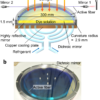Tantalum is one of the rarest elements and has multiple stable isotopes. The least abundant tantalum isotope, Ta-180 is found naturally in a long-lived excited state, a feature unique to this isotope. In excited states, a nuclei’s protons or neutrons have higher than normal energy levels.
Although energetically possible, the radioactive decay of this excited state in Ta-180m has never been observed. Researchers are now conducting experiments that aim to measure this decay, which is expected to have a lifetime approximately 1 million times longer than the age of the universe.
The decay of excited states of nuclei provides insights into how nuclei deform when in those states. Nuclear physicists have extensively studied the variations in shape and the consequent formation of these short-lived isotopes, called isomers. However, they have not thoroughly studied one of the most extreme cases, the decay of Ta-180m.
Physicists can use nuclear theory to predict the decay of Ta-180m based on the knowledge of shorter-lived isomers, but this particular isomer has not been measured. Its exceptional stability challenges existing theories and models of nuclear structure and decay. This means measuring decay in Ta-180m is an unprecedented opportunity to contribute to nuclear theory.
Now, for the first time, scientists have devised an experiment with the required sensitivity to reach the predicted half-lives. The experiment has produced initial data and established the longest limits ever achieved in nuclear isomer studies. The research is published in the journal Physical Review Letters.
In this project, physicists restructured the MAJORANA ultra-low background facility at the Sanford Underground Research Facility in South Dakota. Additionally, they introduced a substantially larger tantalum sample compared to any previously used in similar studies.
Over the course of a year, researchers collected data using germanium detectors boasting exceptional energy resolution. They also developed analysis methods specifically tailored to detect multiple anticipated decay signatures. These combined efforts have enabled them to establish unprecedented limits, falling within the range of 1018 to 1019 years. This level of sensitivity marks the first instance where predicted half-life values from nuclear theory have become reachable.
Although the decay process has not yet been observed, these advancements have significantly enhanced existing limits by one to two orders of magnitude. Furthermore, this progress has allowed researchers to dismiss certain parameter ranges associated with various potential dark matter particles.
More information:
I. J. Arnquist et al, Constraints on the Decay of Ta180m, Physical Review Letters (2023). DOI: 10.1103/PhysRevLett.131.152501
Provided by
US Department of Energy
Citation:
Searching for the decay of nature’s rarest isotope: Tantalum-180m (2024, March 18)



